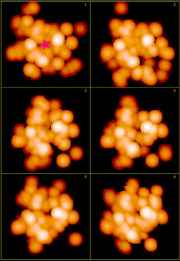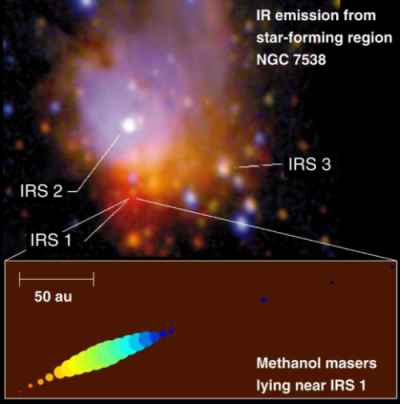
|
Observing Stars with MERLIN and VLBI |
|
Stars are born when a giant cloud of dust and gas collapses under its own weight. Very young stars cannot be detected in visible light due to the remaining dust around them. Radio telescopes can see right to the heart of these regions and reveal that the young stars are ejecting hot surplus material into the cooler gas surrounding them. Observations of Doppler shifts in the very narrow radio emission lines (arising from masers, a naturally occurring analogue to optical lasers) from excited molecules such as methanol (CH3OH) and water vapour (H20), allow us to measure the motions of gas in regions as small as the size of our Solar System. In some cases this gas and dust seems to be forming a disc in orbit around the young star, just as we think happened when the Solar System was born. An example is below.
The building blocks of life For a planetary system like ours to form, perhaps with life on one of the planets, there needs to be heavy elements such as iron, formed inside giant stars, and lighter elements, such as carbon and oxygen. These mostly come from giant red stars such as Omicron Ceti (Mira), which has a diameter as big as the Earth's orbit (2 AU). The whole star is pulsating with a period of 334 days and this helps to drive the equivalent of one or more Earth masses of material out into space every year. Some of this mass is in the form of great clouds of water vapour, typically 1 or 2 AU in diameter, which move away from the star at speeds of 5 to 10 km/s (see left). Stars in close binary systems Unlike our Sun, many stars have a companion star; the two sometimes orbiting closely around each other. The two stars in such a binary system usually have different masses. The more massive star will evolve more quickly and at the end of its life often ejects material forming a planetary nebula and leaving behind an Earth-sized remnant called a white dwarf. Over thousands of years, material from the remaining star can fall onto the white dwarf surrounding it with a layer of hydrogen. Eventually the pressure and temperature at the base of this layer can initiate a thermonuclear explosion -blowing off material at speeds of up to a few thousand km/sec. The light produced by the explosion is so bright that a "new" star can appear in the sky; hence it is called a nova. Novae are often first noted by dedicated amateur astronomers who then report them to the whole astronomical community who can make observations over a wide range of wavelengths. For example, MERLIN has been able to monitor the expansion of the ejected material from one such nova, V723 Cas (see left), which was first observed in 1995 in the constellation of Cassiopeia. For more on stellar research see the High-speed Stellar Ejecta Research pages
|


